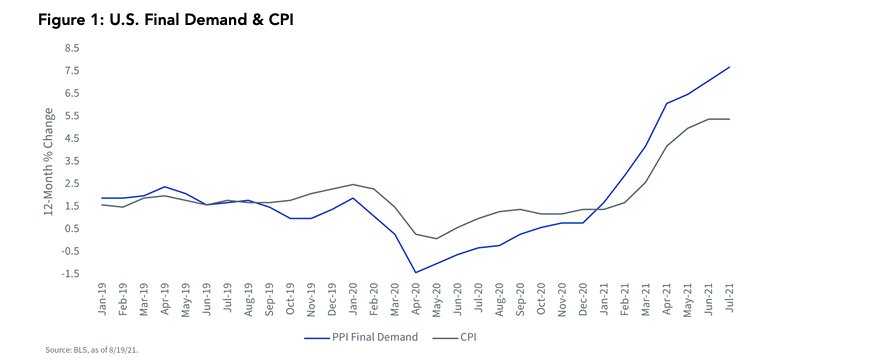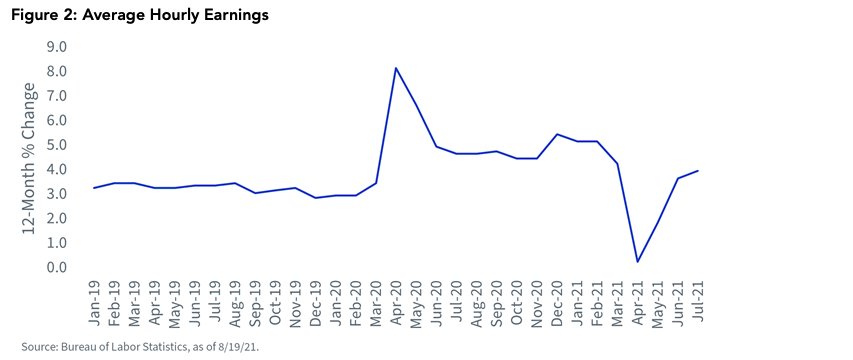By Kevin Flanagan, Head of Fixed Income Strategy
The title of this blog is, without a doubt, what investors are quite eager to find out. Two weeks ago the markets received the July data for both the Consumer Price Index (CPI) as well as the Producer Price Index (PPI). The lion’s share of the headlines tends to go to the CPI, but this report is like looking in the rearview mirror, to coin a phrase. In order to see where the road to inflation may be headed, the PPI figures may provide better insights.
After posting outsized gains in the prior four months, the July CPI increase was pegged at a more moderate 0.5% on a monthly basis. However, the year-over-year rate remained unchanged at its elevated 5.4% reading. Nevertheless, some market participants were quick to point out that the recent string of year-over-year gains had not continued.

This is where the PPI data comes into view. But before I get into that discussion, first some Inflation 101. The PPI report represents price trends at the wholesale level while CPI data represents retail prices. So, in theory, one could make the case that the trend in place for wholesale prices could logically work its way through to the retail level. For the record, it’s not always a clean pass-through, but as you can see from the graph (Figure 1), the trendlines have seemed to fit for the most part over the last few years.
Back then to PPI, where the Bureau of Labor Statistics (BLS) reported that the 12-month increase for the final demand index rose 0.5 percentage points to 7.8%, the largest advance since this data was first calculated in November 2010. Is this a harbinger of what’s to come? At a minimum, it certainly represents a challenge to the ‘inflation is transitory’ case.
You know another trend that bears watching? Wage increases. The graph below underscores how the year-over-year increase for average hourly earnings has been on a roller-coaster ride over the last 12 to 18 months. Prior to the COVID pandemic, the 12-month gain for wages had been rather range-bound around the 3.0% to 3.5% band. Once the economy locked down after February of last year, the increase spiked to as high as 8.2% in April. With low-wage earners being hit disproportionately harder by the lockdown and becoming unemployed, the labor market data was left primarily with the higher-wage worker component. Thus, the spike. As you can see, as the labor market began to normalize, the trend began to reverse, and when the lower-wage worker returned, the 12-month gain actually sank to a low of 0.3% in April of this year.

Now, with a ‘fairer’ representation among those who are employed, one can draw an interesting conclusion; namely, wage gains appear to be gaining traction even with the inclusion of the low-wage earner. In fact, the 12-month increase for July was pegged at 4.0%.
The bottom line message is that if the rising trend in wholesale prices get passed through to households and wage trends become visibly elevated, it is difficult to envision inflation coming back down toward the Fed’s 2% target any time soon, and perhaps, in the foreseeable future.
This post first appeared on August 25 on the WisdomTree blog.
Photo Credit: Dorian Wallender via Flickr Creative Commons
DISCLOSURE
There are risks involved with investing, including possible loss of principal. Foreign investing involves currency, political and economic risk. Funds focusing on a single country, sector and/or funds that emphasize investments in smaller companies may experience greater price volatility. Investments in emerging markets, currency, fixed income and alternative investments include additional risks. Please see the prospectus for discussion of risks.
Past performance is not indicative of future results. This material contains the opinions of the author, which are subject to change, and should not to be considered or interpreted as a recommendation to participate in any particular trading strategy, or deemed to be an offer or sale of any investment product and it should not be relied on as such. There is no guarantee that any strategies discussed will work under all market conditions. This material represents an assessment of the market environment at a specific time and is not intended to be a forecast of future events or a guarantee of future results. This material should not be relied upon as research or investment advice regarding any security in particular. The user of this information assumes the entire risk of any use made of the information provided herein. Neither WisdomTree nor its affiliates, nor Foreside Fund Services, LLC, or its affiliates provide tax or legal advice. Investors seeking tax or legal advice should consult their tax or legal advisor. Unless expressly stated otherwise the opinions, interpretations or findings expressed herein do not necessarily represent the views of WisdomTree or any of its affiliates.



